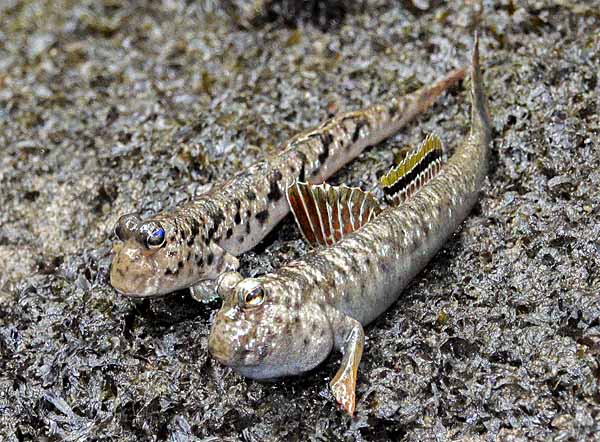Periophthalmus variabilis
Eggert, 1935
|
Familie: Gobiidae SynonymePeriophthalmus variabilis variabilis Eggert, 1935 |
Typen
Neotypus: MZB 15501.
Siehe: Eschmeyer, W.N., Fricke, R. & Van der Laan, R. (eds.) 2024. Catalog of Fishes electronic version
Typusfundort: Hutan Payau, Tritih, Cilacap, Zentral-Java, Indonesien.
Etymologie
Variabilis (= variabel), bezogen auf die starke Variabilität der Zeichnung und Form der ersten Rückenflosse. (Übersetzt aus: The ETYFish Project)
Verbreitung
Östlicher Indischer Ozean, westlicher Pazifik: östliche Andamanensee (Thailand) östlich bis Südvietnam, südlich bis Sumatra und Java (Indonesien).
IUCN Status

EX Extinct (ausgestorben)
EW Extinct in the Wild (in der Natur ausgestorben)
CR Critically Endangered (vom Aussterben bedroht)EN Endangered (stark gefährdet)
VU Vulnerable (gefährdet)
NT Near Threatened (potenziell gefährdet)
LC Least Concern (nicht gefährdet)
RE Regionally Extinct (regional oder national ausgestorben)DD Data Deficient (ungenügende Datengrundlage)
NE Not Evaluated (nicht beurteilt)
Status: Stand 25.02.2023: NE Not Evaluated (nicht beurteilt)
Gefahren für diese Art: (nicht beurteilt)
Literatur
- Eggert, B. 1935. Beitrag zur Systematik, Biologie und geographischen Verbreitung der Periophthalminae. Ergebnisse einer durch die Notgemeinschaft der Deutschen Wissenschaft ermöglichten Reise nach Niederländisch-Indien ...der Deutschen Wissenschaft 1929--1930. Zoologische Jahrbücher, Abteilung für Systematik, Geographie und Biologie der Tiere (Jena), 67: 29-116, Pls. 1-9. Zitatseite [:64, Pl. 3 (fig. 13); Fig. 5, !!, als Periophthalmus variabilis; :66, Fig. 7, !!, als Periophthalmus variabilis asiaticus; :65, Pl. 4 (figs. 14-15); Fig. 6, !!, als Periophthalmus variabilis sumatranus; :67, Fig. 8, !!, als Periophthalmus variabilis tidemani]
- Murdy, E.O. 1989. A taxonomic revision and cladistic analysis of the oxudercine gobies (Gobiidae: Oxurdercinae). Records of the Australian Museum, Supplement 11: 1-93. Zitatseite [:43, als Synonym von Periophthalmus novemradiatus]
- Talwar, P.K. & Jhingran, A.G. 1991. Inland fishes of India and adjacent countries. In 2 vols. Oxford & IBH Publishing Co., New Delhi, Bombay, Calcutta. v. 1-2: i-xvii + 36 unnumbered + 1-1158, 1 pl, 1 map. Zitatseite [:966, gültig als Periophthalmus variabilis]
- Rema Devi, K. 1993. Fishes of Kalakad Wildlife Sanctuary, Tirunelveli District, Tamil Nadu, India, with a redescription of Horalabiosa joshuai Silas. Records of the Zoological Survey of India, 92 (1-4)[1992]: 193-209. Zitatseite [:184, versehentlich als Periophthalmus varlabillis]
- Jaafar, Z. & Larson, H.K. 2008. A New Species of Mudskipper, Periophthalmus takita (Teleostei: Gobiidae: Oxudercinae), from Australia, with a Key to the Genus. Zoological Science, 25: 946-952. Zitatseite [:951]
- Jaafar, Z., Perrig, M. & Chou, L.M. 2009. Periophthalmus variabilis (Teleostei: Gobiidae: Oxudercinae), a Valid Species of Mudskipper, and a Re-diagnosis of Periophthalmus novemradiatus. Zoological Science, 26 (4): 309-314. Zitatseite [:309, 311, 313; unnötiger Neotypus festgelegt; Unterarten als Synonyme betrachtet]
- Murdy, E. 2011. Systematics of Amblyopinae. Chapter 1.8, Pp. 107-118. In:
- Patzner, R.A., van Tassell, J.L., Kovacic, M. & Kapoor, B.G. (eds.) 2011. The biology of gobies. CRC Press, Science Publishers, Enfield, N. H. Zitatseite Zitatseite [:105]
- Kottelat, M. 2013. The Fishes of the Inland Waters of Southeast Asia: A Catalogue and Core Bibliography of the Fishes Known to Occur in Freshwaters, Mangroves and Estuaries. The Raffles Bulletin of Zoology, Supplement No. 27: 1–663. (PDF) Zitatseite [:420]
- Konstantinidis, P., Jaafar, Z., Warth, P., Stoll, M. & Hossfeld, U. 2016. Rediscovery of oxudercine type specimens (Teleostei: Gobiidae) assumed destroyed during World War II. Ichthyological Research, 64 (1): [1-8] 123-130. (doi) Zitatseite [:[5]]
- Setiawan, A., Iqbal, M., Priscillia, B., Pormansyah, Setiawan, D. & Yustian, I. 2019. Linking a gap, first record of dusky-gilled mudskipper Periophthalmus variabilis Eggert, 1935 (Perciformes: Gobiidae) in southern Sumatra, Indonesia. Ecologica Montenegrina, 24: 11-16. (doi) Zitatseite [:12]
- Kühne, J. 2023. Sarawak. Flachland- und Marschbiotope in Küstenregionen von Borneo. Aquaristik Fachmagazin, #289, 55 (Feb./März): 40-43. Zitatseite [:43*, Farbfoto, Biotop]
